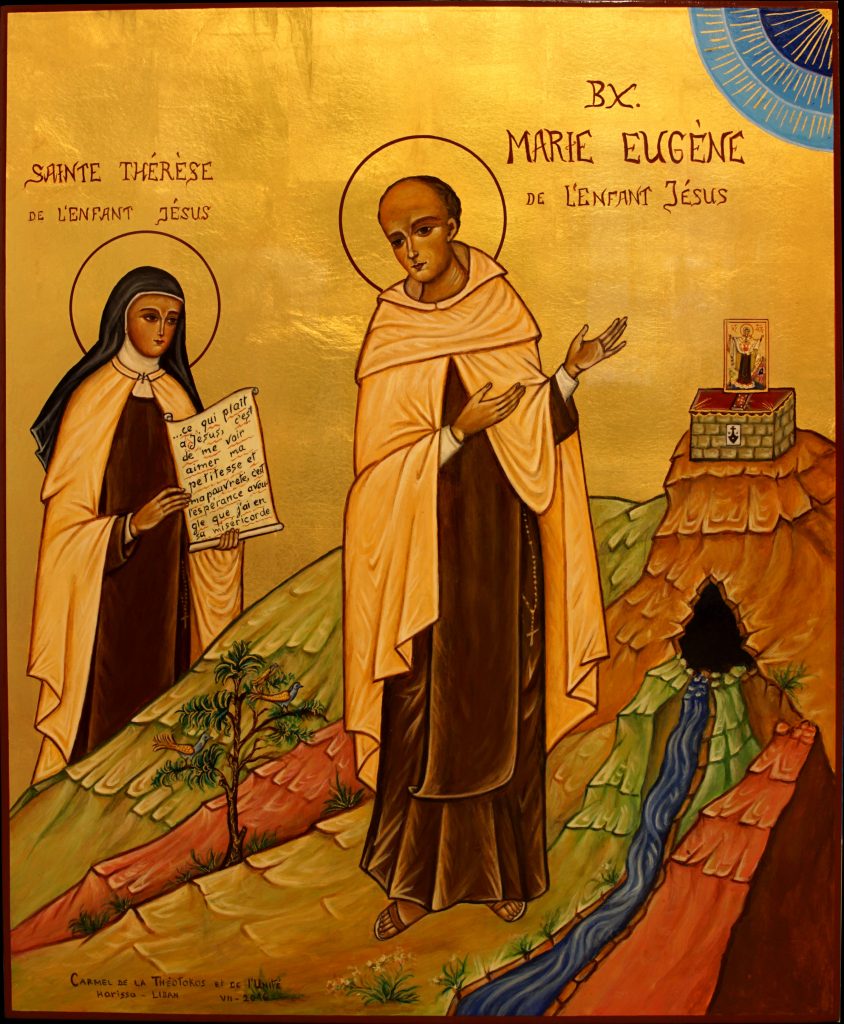A nun from the Carmel of the Mother of God and Unity in Harissa, Lebanon, “wrote” this icone at the request of Archbishop Cattenoz.
This icon aims at reflecting Fr. Marie-Eugene’s life and soul in God’s light :

Here are a few interpretative keys :
Blessed Father Marie-Eugene, standing in the center, is wearing the habit of his Order. Mount Carmel, which he climbs as a son of Saint John of the Cross, is visible on his left. At its summit is the altar on which he offers the Sacrifice and is himself offered in sacrifice, as was Christ. On his deathbed, he said: “Jesus, I love You! It seems to me that I love You perfectly and that I resemble You!”
Mary, tiny on the altar icone, and the Holy Spirit, whose rays shine forth from the corner circles, are his WHOLE LIFE.
This Mother works discreetly in his soul and makes it bear fruit. His intimate union with Her (represented by the scapular he wears, and the rosary) finds abundant expression in the work which Mary Herself founded:
“Our Lady of Life”, this “something” that Father Marie-Eugene discovered little by little.
As for the Holy Spirit, He inspires and attracts him:
These “rivers of Life” are represented as gushing forth from the black chasm, black from the darkness of Faith lived out in prayer and suffering.
Father Marie-Eugene’s hands are raised toward God, highlighting the attitude of trusting prayer that characterizes him, for he knows he receives everything from God’s grace when he lets himself be led by his grace, as his motto expresses: “Traditus gratiae Dei” (surrendered to God’s grace).
Totally oriented toward God, we nevertheless see him turning toward Little Therese: his prayer life makes his thirst for God increase. He looks to the one who shows him the shortest way: love you littleness, your poverty and hope blindly in the Mercy of Jesus. That’s what Saint Therese is showing us on her parchment.
Concerning her parable of the “little bird”, Father Marie-Eugene commented on Therese’s prayer; he wrote:
Looking at the icone we can hardly see, in the bush, little birds representing this poor prayer taught by Father Marie-Eugene, but lived by him even more. They also represent that legion of little souls that Saint Therese had asked Our Lord to choose, and to which Father Marie-Eugene belongs.
The mountains between Saint Therese and Blessed Father Marie-Eugene signify separation and elevation: from Heaven above, Little Therese directly influenced his life and mission, raising his soul and that of many others with him, toward Heaven.
In his thirst, in turn, to give souls to Jesus, with a prophetic spirit (symbolized by the white cape of the Prophet Elijah’s sons), Father Marie-Eugene saw other souls’ own thirst for the life of silent prayer. “Notre-Dame de Vie” was founded so that apostolic action and contemplation would always be closely united in the Christian life.
“Of the Child Jesus,” Saint Therese and Blessed Father Marie-Eugene’s shared name, is visible on the gold background. Both of them seem to lead along this path of spiritual childhood, those who, by contemplating this icone, let themselves encounter their gaze.
